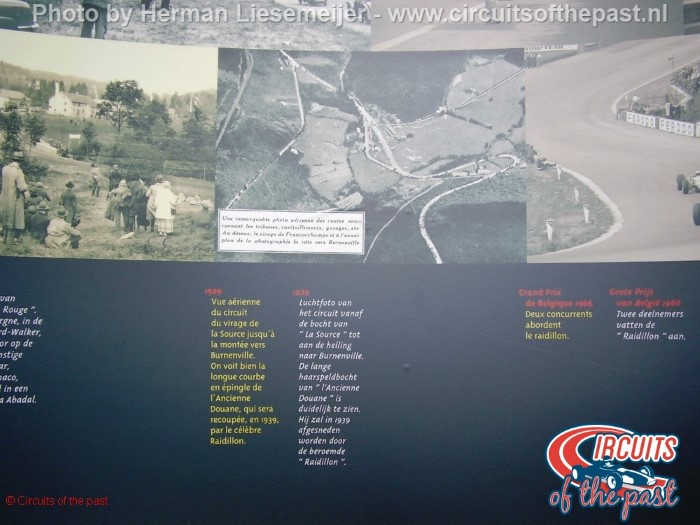Change language: Dutch (Nederlands) ![]()
This page is dedicated to the most famous corner of Spa-Francorchamps, the Raidillon, by mistake often called Eau Rouge. In this article I tell you about the construction of the corner and the confusion about the name. Also information about the temporary chicane from 1994.
The World famous corner
The Raidillon is the steep fast right-hander which starts on the remain of the old Eau Rouge corner. Since 1939 the Raidillon is cutting off the l’Ancienne Douane section.
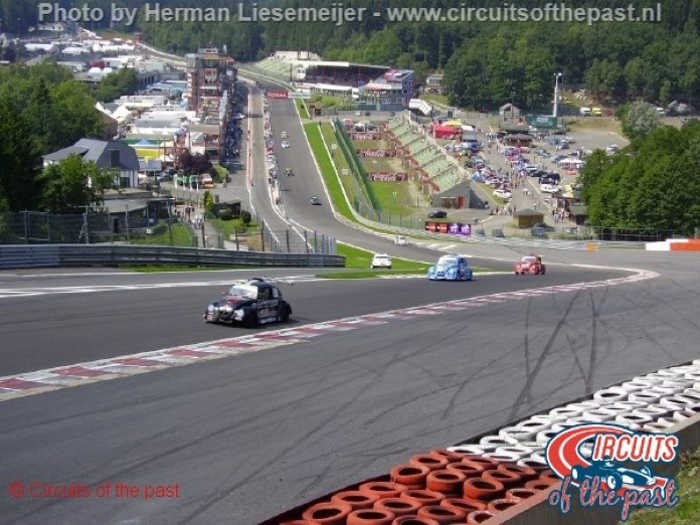
In the thirties there was a competition between the circuit owners to have the fastest track. Francorchamps didn’t want to stay back so they decided to built this artificial corner. The corner has a gradiënt of 17% and an elevation of 134 Feet (40.8 Meters).
The Raidillon became one of the most beloved and feared corners in the world. While accelerating from the La Source hairpin down the straight you see these massive mountain in front of you which looks very intimidating!
While touring cars enter the Raidillon about 200 km/h (125 Mph), Formula one cars do almost 300 km/h (185 Mph) at this point. With a well-trimmed car the bravest drivers will take this corner flat out! That’s very important because after this corner comes the long Kemmel Straight.
Eau Rouge… Raidillon? The name confusion
A mondegreen is the mishearing or misinterpretation of a phrase in a way that gives it a new meaning. There is a big misunderstanding about the name of the Raidillon which is called Eau Rouge by many people. You can call that a mondegreen too.
Just in front of the Raidillon flows the brook Eau Rouge underneath the track. At this point was the original left-hand corner leading to the l’Ancienne Douane hairpin. This corner was named after the brook Eau Rouge.
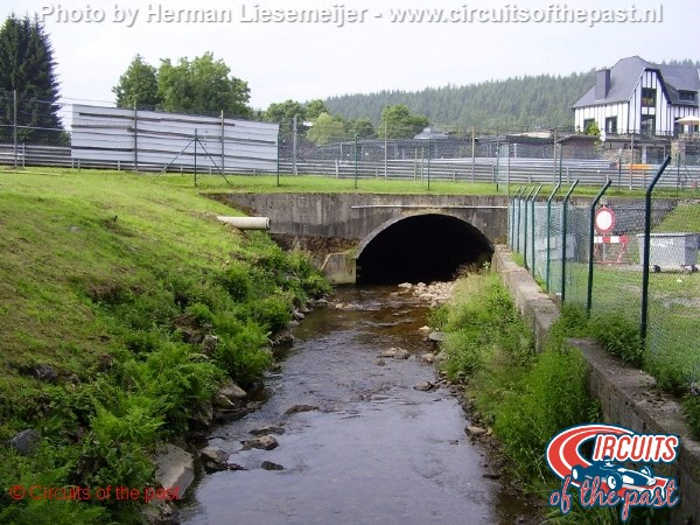
This is the real Eau Rouge!
Misinformation
Some sources tell that Raidillon is the name of the left-hand corner on top of the series. But this is not true!
On the official website of the Spa-Francorchamps Circuit we find this phrase: “The removal of the old Customs bend and the construction of a spectacular curve whuich was baptised the Raidillon, more often called the Eau Rouge bend by foreigners.”
Source: www.spa-francorchamps.be
So, the one and only Raidillon was introduced in 1939 and is the steep shortcut that replaced the “customs bend”, which is a too literal translation of l’Ancienne Douane. Raidillon is French for steep road, so there should actually be no doubt which section is meanth with this name.
“Raidillon on the Eau Rouge”
From the original left-hand corner the Eau Rouge is just a part still in use. Because the Raidillon is attached to a remain of the Eau Rouge corner, Belgian journalists speak also from the “Raidillon on the Eau Rouge”. Some sources claim this is the official name. Actually, I thought it also for many years. But when I did investigation in the Musée du Circuit in Stavelot, I didn’t found any evidence for that.
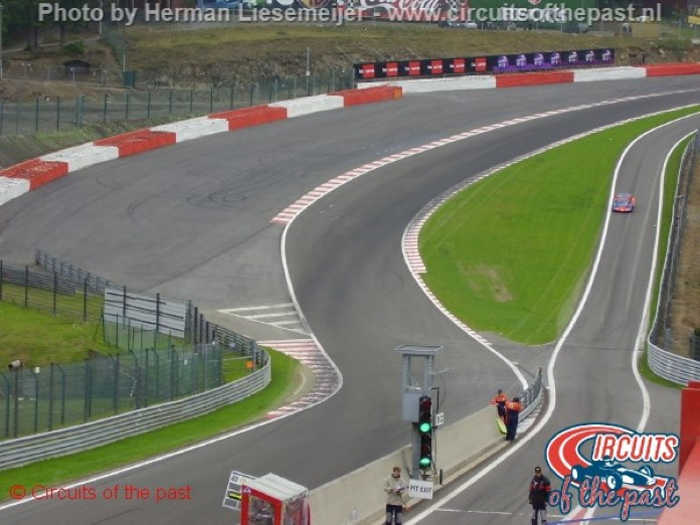
As already mentioned, many people think that the Raidillon is only the left kink after the steep corner. But this one is part of the Raidillon combination. Only about the left kink below you can still argue whether it is the Eau Rouge, because it is a remnant of the original Eau Rouge Corner.
Eau Rouge, a persistent misunderstanding…
Because journalists, reporters and even drivers parroting each other without having to delve into the facts, most people will believe that the name of the Raidillon is Eau Rouge. That’s how the misunderstanding remains intact. A misunderstanding that has adopted world wide proportions!
On this picture above (click to enlarge), made in Musée du Circuit at Stavelot, you see the old l’Ancienne Douane section and a little story about the construction of the Raidillon. Because the texts are in French and Dutch here an English translation: “Aerial view of the circuit from the corner La Source to the bank to Burnenville. The long hairpin of “l’Ancienne Douane” is clearly visible. He was cut off in 1939 by the famous Raidillon.”
A funny Video about the name confusion of the world’s most famous corner.
Why is “Eau Rouge” so persistent?
You now know that the name of the famous corner at Spa-Francorchamps is Raidillon and not Eau Rouge. For some reason this discussion is always very heated.
Responses to this can be divided into three categories:
1. The smallest group recognizes that Raidillon is the correct name and also calls it Raidillon.
2. By far the largest group persists in ‘Eau Rouge’ and makes up an excuse to keep using the wrong name, despite all the evidence in this article.
The three most commonly used excuses are:
“When everyone says ‘Eau Rouge’, it is popularly called ‘Eau Rouge’.”
It sounds reasonable in itself. But even when a large group does or says something wrong, it remains wrong.
“To me it’s called ‘Eau Rouge’, as it is to millions of other people.
Basically the same as the previous one. Those millions of people have been misinformed, but it remains wrong.
“Two names for a corner combination is too much, that’s why I call the whole corner combination ‘Eau Rouge’.”
This is a very peculiar reasoning. Because for the corner combination ‘Maggots, Becketts and Chapel’ at Silverstone, three names seem no problem at all. Besides, ‘Raidillon’ is actually the name of the whole corner combination.
3. Then there is also a group that does not make excuses but reacts aggressively. The messenger is verbally shot and called a whiner and other ugly things.
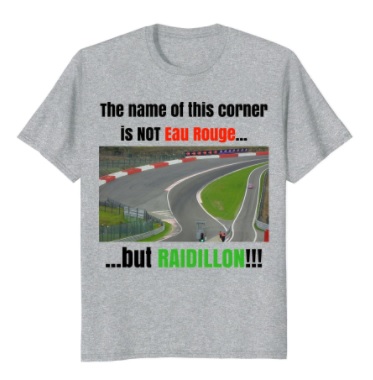
Why ‘Eau Rouge of Raidillon’ heats up so much
Besides racing circuits I have other interests. One is psychology. In view of that, it fascinates me that this issue is heating up so much. And so I went looking for an explanation for that.
Can’t handle criticism
Most people don’t like being criticized. Usually it involves criticism of a certain behavior, such as using the wrong name in this case. But often this is taken as a critique of one’s entire personality.
This stems from a deep insecurity. To admit a mistake you have to be strong. Rather, it is a sign of strength to acknowledge a mistake and learn from it. Reacting aggressively is actually a sign of weakness.
Herd Behavior
But the root cause of persistence in error is herd behavior! To understand that, we have to go back to prehistoric times, when people lived in tribes. It was vital at the time not to fall outside the group. If you did and continued alone, you were easy prey for enemy tribes and predators.
In order not to fall outside the group, the views and opinions of the group were also adopted. These views and opinions were imposed by the most dominant person in the group, who had appointed himself chieftain.
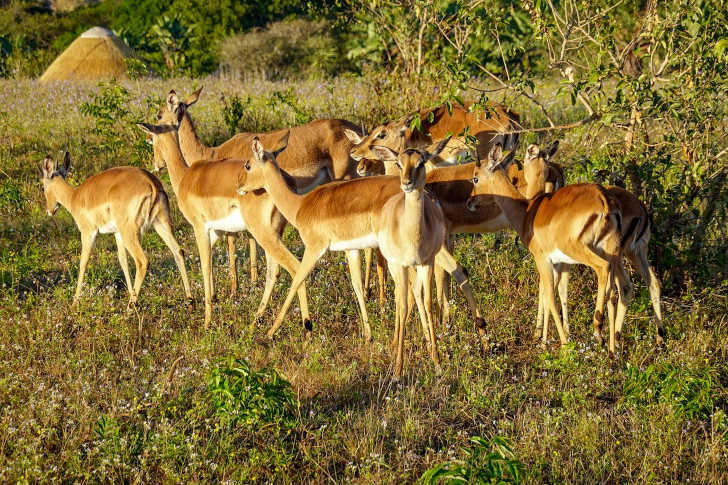
Today it is no longer vital to be part of a tribe. But the fear of falling outside the group of family, friends or colleagues is still deeply entrenched in our brain.
So when almost everyone around you calls the famous corner at Spa-Francorchamps ‘Eau Rouge’, few dare to say that it is Raidillon actually. This is out of fear of being rejected by the majority of the group and thereby falling outside the group.
The chicane in the Raidillon in 1994
It was the tragic year 1994. In the third race weekend of the season, the San Marino Grand Prix at Imola, Austrian Roland Ratzenberger crashed during qualifyingin in the fast Villeneuve Corner and died. It was the first fatality in a Formula One event since 1982 (NB: In 1986 Elio de Angelis died during tests at Paul Cicard in France).
After the initial shock came the first relativization, “motorsport is dangerous”. But the next day the Formula One was in a much deeper schock when the legendary Ayrton Senna crashed in the also very fast Tamburello Corner and died the same day in the hospital. Now the sport was in deep mourning and hardly knew how to respond.
During an emotional meeting they decided to re-establish the Grand Prix Drivers Association to engage in the safety of the drivers. New security requirements were imposed on the circuits, which actually meant that a lot of fast corners should disappear. Ferrari driver Jean Alesi was the first who brought up the Raidillon. He declared that he would not compete at Spa-Francorchamps unless drastic security measures would be taken…
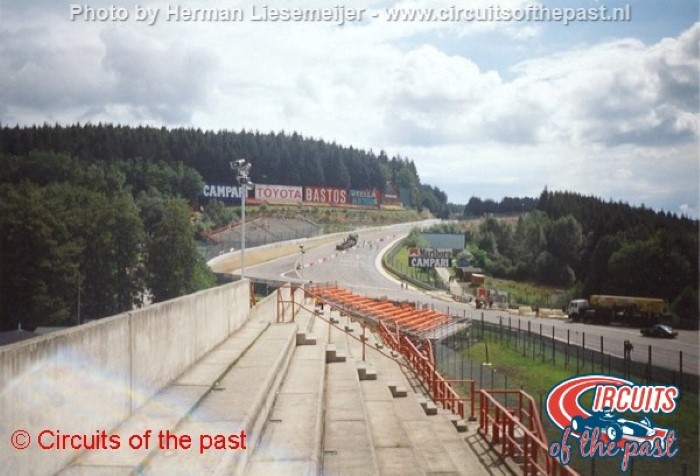
“Drivers so wrong about Raidillon”
The result was the construction of a temporary chicane that started at the bottom kink and made a sharp turn parallel to the Raidillon. For the next year they increased the run-off area and the chicane was not used anymore.
Most drivers were satisfied that the Raidillon was restored, but there was also criticism. “Drivers so wrong about Raidillon” wrote BBC commentator Murray Walker (or did he said Eau Rouge?) in his preview. In his opinion, the Raidillon is one of the most dangerous corners in the world. The enthusiasm of the drivers about this corner should come from a kind of romantic view.
A weak link in the safety of the Raidillon was the big concrete grandstand on the outside. To maximize the run-off area it was partially extended around the stand. The result was the grandstand standing with one vertex in the run-off area! To protect drivers for this they placed a huge amount of tyre stacks in front of it. Later the grandstand was demolished and replaced by a new one, outside the run-off area. The run-off area itself is now paved with asphalt.
Read also the article: The History of Spa-Francorchamps >>
Do you want to hear more funny misconceptions in motorsport? Then watch this video!
So much for this article about the biggest name change in motorsport. Feel free to respond, but keep it tidy 😉
© Text & photos: Herman Liesemeijer
Subscribe to our YouTube Channel: youtube.com/circuitsofthepast



